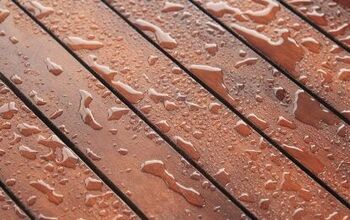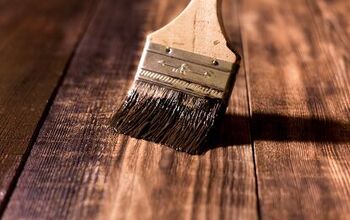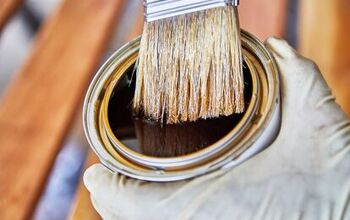Can You Stain Wood In Cold Weather?

Staining your deck is a time-honored part of being a homeowner in the suburbs. Without a good stain, your deck will be prone to termites and other pests. It also will look crappy. We often hear that it’s best to stain a deck in the spring or summer, but sometimes, you might want to try to do it in the winter. Is staining wood doable in cold weather, though?
You can’t stain wood in cold weather. Wood stain will not be able to keep its consistency stable compared to warm weather. In order for wood stain to remain spreadable, you have to use it in temperatures that are 50 to 90 degrees Fahrenheit.
If you want to give your deck a touch-up in the middle of January, you are probably out of luck. It’s time to take a closer look at what you should know before you try to stain a deck in cold weather.
Do You Need Exterior Home Paint or Stain Services?
Get free, zero-commitment quotes from pro contractors near you.

Is It Possible To Stain A Deck In Cold Weather?
Honestly, in most cases, it’s not. Most stains will not work in temperatures lower than 50 degrees Fahrenheit, and that really isn’t that cold. Some wood stains might be able to eke out a little functionality in temperatures as low as 40 degrees, but even then, it is not guaranteed by any means of the word.
What Happens If You Try To Stain A Deck In Cold Weather?
There are quite a few drawbacks that can occur if you try to stain your deck in weather that is too cold to do so. Here are the biggest complaints you might have:
- The stain might not actually dry. The colder the area is, the longer it will take your deck to dry. Extremely cold (but not freezing) weather will cause your stain to stay wet for days. This can reduce the quality of the stain when it dries, or even give the stain the opportunity to wash away.
- If it’s extremely cold, you might not even be able to stir the stain. Some stains will get thick or chunky. It’s rare, but it can happen. I’ve heard brief anecdotes of stains that have actually frozen or had water stuck to the edges of the can.
- In some cases, your stain also may not be able to adhere to the deck at all. Let’s say you decide to stain a deck in freezing weather. The stain will most likely not be able to adhere to your deck. It’ll slide off as soon as you try to wipe it down. If it does stay, the curing process will be interrupted. This will lead to discoloration.
- If you somehow manage to get the stain in wildly cold weather, it might freeze. I haven’t heard of this happening, but if you recently invested in Antarctic living as a result of global warming, things could get dicey.
What Is The Coldest Temperature A Deck Stain Can Handle?
A deck stain is not meant to handle too much cold. Most stains will stop being able to work well by the time the temperatures drop below 50. Some stains that are made for areas with a colder climate might be able to work at temperatures as low as 40 degrees, but they are in the distinct minority.
Is There Any Way To Make It Possible To Stain A Deck In Cold Weather?
Possibly. You might be able to make it work if you have space heaters that keep the deck warm in the cold weather. You also will have to find a way to raise the temperature of the stain’s canister to 70 degrees or so, too. This is the only way to ensure that you could get the stain to dry. Even then, it’s not guaranteed that the stain will work as well as it should.
What Is The Ideal Temperature For Staining Your Deck?
As we have said before, most deck stains will work between 50 to 90 degrees Fahrenheit. No more, no less. According to most experts, the best temperature for deck staining will be 70 degrees. This ensures that you will get a good dry time with enough breathing room to correct any mistakes that you make before it cures.
What Happens If You Stain Your Deck In Super Hot Weather?
Extreme heat has the opposite effect of cold weather. In hot weather, your stain will cure faster than it should. This can mean that your stain will end up drying very fast, to the point that you may start seeing streaking on your deck. If you are not able to finish quickly, this can lead to a very unsightly look.
In very high temperatures over 110, you may not be able to actually spread your deck stain. It’ll start to thicken up, just like it would in extremely low temperatures. Besides, do you *really* want to be out doing hard labor in the middle of a heatwave? I think not.
Is There Anything Else You Should Know About Staining Your Deck?
Temperature is only half of the equation when it comes to choosing a good time to stain your deck. The other major issue to consider is the rain and humidity levels. Humid weather and precipitation can both make it hard for your stain to properly cure. Worse, high rain can actually wash the stain away before it even takes hold.
If you want to make sure that you get the most out of your deck staining, it’s best to schedule your stain session for a day that will have at least three days without rain after. The three days tailing your stain day will ensure that you get the right cure time for everything.
Do You Need Exterior Home Paint or Stain Services?
Get free, zero-commitment quotes from pro contractors near you.

Related Questions
Can I stain my deck during the winter?
This is actually all based on where you live. In most parts of the country, the average temperature in winter dips far below the 50-degree limit. However, this is not always the case. If you live in a place like Florida or Texas, it’s quite possible you will be able to schedule out a couple of days where temperatures will be warm enough for you to do things the right way.
How frequently are you supposed to stain your deck?
Deck staining is one of those things that can vary in frequency depending on how much wear and tear your deck gets. Most people will need to stain their decks every two to three years. If you had a major storm that caused serious damage or flooding, then you may need to stain your deck within 1 to 2 weeks of the storm. This helps prevent additional rot and damage.
Can you seal a deck in cold weather?
Sealing a deck is something that should be treated just like staining if you want to get good results. Much like stain, deck sealant will only be able to go on in temperatures between 50 to 90 degrees Fahrenheit. This means that sealing a deck in temperatures that most people would consider cold (like freezing) would be a bad idea.In order to make sure that you get a good sealing session on, try to schedule your deck sealing in a period of three days that each have a forecast that remains above 50 degrees. The warmer, the better.

Ossiana Tepfenhart is an expert writer, focusing on interior design and general home tips. Writing is her life, and it's what she does best. Her interests include art and real estate investments.
More by Ossiana Tepfenhart



























